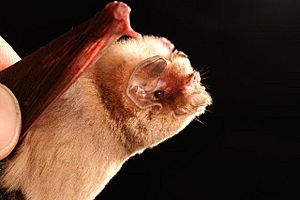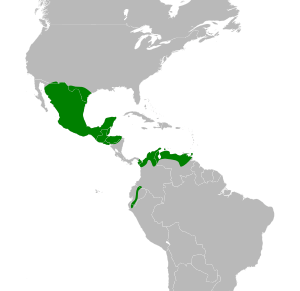Ghost-faced bat facts for kids
Quick facts for kids Ghost-faced bat |
|
|---|---|
 |
|
| Conservation status | |
| Scientific classification | |
| Genus: |
Mormoops
|
| Species: |
megalophylla
|
 |
|
The ghost-faced bat (Mormoops megalophylla) is a unique type of bat. It gets its name from its unusual face, which looks a bit "smashed-in" because of its flat nose and large ears that seem to connect across its forehead. These bats are active at night and use echolocation to find their way around and hunt for food.
You can find ghost-faced bats in many places, including Belize, Colombia, Ecuador, El Salvador, Guatemala, Honduras, Mexico, Peru, Trinidad and Tobago, Venezuela, and even in Texas in the United States. It's one of only two living species in its group, called Mormoops. The other one is the smaller Antillean ghost-faced bat.
Contents
What Does a Ghost-Faced Bat Look Like?
Ghost-faced bats are medium-sized. They have fur that can be reddish-brown to dark-brown. The reddish color often becomes brighter as the bat gets older.
Their face looks quite unusual. This is because their nose isn't very developed, and their forehead rises sharply from their nose. Also, their faces have thick skin and muscles, and their big, round ears look like they join together over their forehead.
These bats usually have a body temperature that's a bit warmer than the air around them. This means they don't do well in cold places. If the temperature drops below 10 °C (50 °F), they can only survive for a few hours before getting too cold.
Where Do Ghost-Faced Bats Live?
Ghost-faced bats live in places that are humid, dry, or semi-dry. They prefer areas that are not too high up, usually below 3,000 meters (about 9,800 feet).
In the United States, they have been found in southern Texas and Arizona. They also live in Mexico and across eastern Honduras and El Salvador. Interestingly, they don't seem to live in Nicaragua, Costa Rica, or Panama.
You can find them again along the Caribbean coast of South America in countries like Colombia, Venezuela, and Trinidad and Tobago. They also live along the Pacific coasts in Colombia, Ecuador, and northern Peru.
Scientists have found very old fossils of these bats from the late Pleistocene era. Back then, they lived in even more places than they do today. Fossils have been found as far north as Florida and on many Caribbean islands, including Cuba, Jamaica, Hispaniola, Bahamas, Trinidad and Tobago, and Aruba.
How Do Ghost-Faced Bats Live?
Ghost-faced bats love warm weather. They usually live together in large groups, called colonies. However, they don't huddle close together. Each bat likes to keep about 15 cm (6 inches) of space from its neighbors.
When they leave their roosting spots at night, which are often caves, old mine shafts, or tunnels, they fly out in fast, dense groups. Once they reach their feeding areas, they spread out to hunt.
These bats mostly eat large moths. They are often seen catching insects over still water. Because they live in big colonies, they can sometimes get sick from parasites or diseases like rabies. These illnesses have been known to wipe out entire groups of bats.
What Do Ghost-Faced Bats Eat?
The ghost-faced bat eats small insects. They are excellent hunters in the dark because they use echolocation. This means they send out sounds and listen for the echoes to create a "sound map" of their surroundings. This helps them find and catch insects even when there's no light.
Reproduction and Life Cycle
Scientists don't know a lot about how ghost-faced bats reproduce and grow. It seems that female bats usually carry only one baby at a time. They are thought to give birth in the spring, between March and June. Mothers have also been seen feeding their young with milk between June and August.
Pregnant female bats are very sensitive to changes in temperature. Because of this, they often roost deeper inside caves than the rest of the colony. This deeper part of the cave has less air movement and stays warmer, which is important for the mothers and their young.
See also
 In Spanish: Mormoops megalophylla para niños
In Spanish: Mormoops megalophylla para niños


